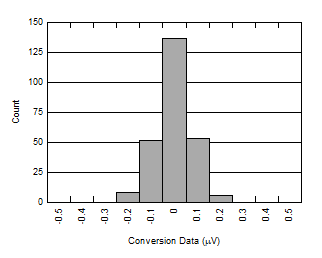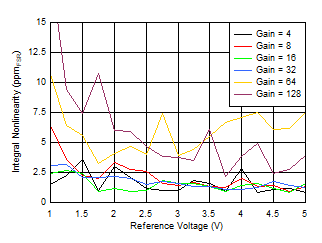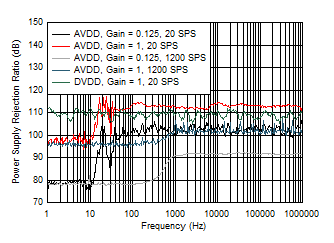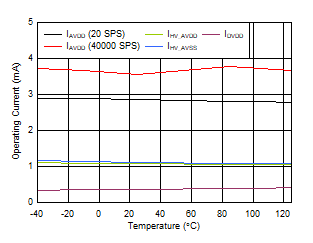JAJSGG2C October 2018 – June 2019 ADS125H02
PRODUCTION DATA.
- 1 特長
- 2 アプリケーション
- 3 概要
- 4 改訂履歴
- 5 概要(続き)
- 6 Device Comparison Table
- 7 Pin Configuration and Functions
- 8 Specifications
- 9 Parameter Measurement Information
-
10Detailed Description
- 10.1 Overview
- 10.2 Functional Block Diagram
- 10.3 Feature Description
- 10.4 Device Functional Modes
- 10.5 Programming
- 10.6
Register Map
- 10.6.1 Device Identification (ID) Register (address = 00h) [reset = 6xh]
- 10.6.2 Main Status (STATUS0) Register (address = 01h) [reset = 01h]
- 10.6.3 Mode 0 (MODE0) Register (address = 02h) [reset = 24h]
- 10.6.4 Mode 1 (MODE1) Register (address = 03h) [reset = 01h]
- 10.6.5 Mode 2 (MODE2) Register (address = 04h) [reset = 00h]
- 10.6.6 Mode 3 (MODE3) Register (address = 05h) [reset = 00h]
- 10.6.7 Reference Configuration (REF) Register (address = 06h) [reset = 05h]
- 10.6.8 Offset Calibration (OFCALx) Registers (address = 07h, 08h, 09h) [reset = 00h, 00h, 00h]
- 10.6.9 Full-Scale Calibration (FSCALx) Registers (address = 0Ah, 0Bh, 0Ch) [reset = 00h, 00h, 40h]
- 10.6.10 Current Source Multiplexer (I_MUX) Register (address = 0Dh) [reset = FFh]
- 10.6.11 Current Source Magnitude (I_MAG) Register (address = 0Eh) [reset = 00h]
- 10.6.12 Reserved (RESERVED) Register (address = 0Fh) [reset = 00h]
- 10.6.13 MODE4 (MODE4) Register (address = 10h) [reset = 50h]
- 10.6.14 PGA Alarm (STATUS1) Register (address = 11h) [reset = xxh]
- 10.6.15 Status 2 (STATUS2) Register (address = 12h) [reset = 0xh]
- 11Application and Implementation
- 12Power Supply Recommendations
- 13Layout
- 14デバイスおよびドキュメントのサポート
- 15メカニカル、パッケージ、および注文情報
パッケージ・オプション
メカニカル・データ(パッケージ|ピン)
- RHB|32
サーマルパッド・メカニカル・データ
- RHB|32
発注情報
8.8 Typical Characteristics
at TA = 25°C, HV_AVDD = 15 V, HV_AVSS = –15 V, AVDD = 5 V, DVDD = 3.3 V, VREF = 2.5 V, fCLK = 7.3728 MHz, data rate = 20 SPS, and gain = 1 (unless otherwise noted)
| V(AINx) = 0 V |

| Gain = 0.1875, data rate = 1200 SPS, sinc1 filter, calibrated offset,
en = 13.6 µVRMS |

| Gain = 32, data rate = 20 SPS, FIR filter, calibrated offset,
en = 0.076 µVRMS |

| Gain = 4 to 128, data rate = 20 SPS |

| Gain = 1 |




| Input range limited to: ±4 V / Gain when VREF > 4 V |

| Gain = 1 |

| Auto-zero mode |

| 32 units, gain = 32, after calibration |

| Gain = 4 to 128, after calibration |


| Gain = 4 to 128 |

| 32 units, gain = 32, after calibration |

| Measurement input range limited to: ±4 V / Gain when VREF > 4 V |



| TA = 25°C |

| IDAC = 250 µA |

| AVDD and DVDD |

| VIN = 2.5 V |

| Gain = 1, data rate = 40000 SPS, calibrated offset,
en = 37 µVRMS |

| Gain = 0.125 to 2, data rate = 20 SPS | ||

| Gain = 0.125 |

| Gain = 16 |



| Input range limited to: ±4 V / Gain when VREF > 4 V |

| Gain = 0.125 |

| Gain = 32 |

| Gain = 0.125 to 2, after calibration |


| Gain = 0.125 to 2 |

| Measurement input range limited to: ±4 V / Gain when VREF > 4 V |

| TA = –40°C to +125°C |


| IDAC = 250 µA |


| HV_AVDD and HV_AVSS |

| All gains |



